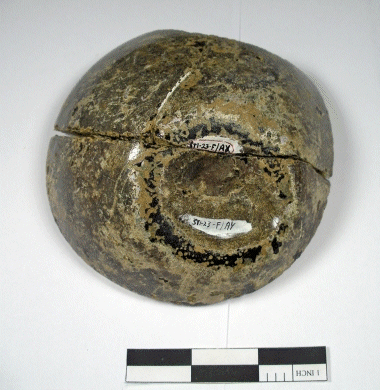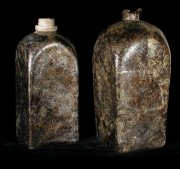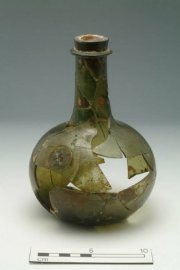Glass Bottle

Conservator’s Notes
A recent grant from the IMLS allowed HSMC to evaluate and treat any unstable and previously treated glass in the collections. Stabilization and consolidation of fragile glass was carried out by trained staff members until the museum hired its first professional conservator in the late 1980s. This professional conservator refined procedures. Now, the standard process includes dewatering glass post-excavation and drying, using solvent baths followed by vacuum impregnation of a stable acrylic resin system.
Some of the glass treated using yesterday’s “best practices” were showing signs of deterioration The resin used was beginning to fail, lifting off the surfaces as the unstable material continued to decay.. Pieces of glass mended together were pulling apart.
This bottle base was suffering from such damage. The unstable adhesive used to mend the piece over 30 years ago, plus the weight of the glass base, was causing the piece to pull apart over time. To conserve the piece, the old adhesive was removed, the glass edges were cleaned and treated in the laboratory and then a new, stable adhesive was used to re-mend the glass bottle base. The increased stability and strength of modern adhesives should prevent the same damage from occurring in the future. The vessel can now be handled, studied and exhibited without further damage.
Curator’s Notes
Round glass bottles were introduced around 1650, and shortly thereafter begin appearing on colonial sites in the Chesapeake. Before that time, the only glass bottles available were square bottles, referred to as case bottles since they could be fitted into special wooden cases with square compartments. Once introduced, round bottles became one of the most common of glass containers. These vessels could be made rapidly since they are simply formed by free-blowing the bottle. Case bottles required the use of molds..
Bottle shape went through a series of evolutionary steps. The earliest were referred to as “globe and shaft” bottles which had relatively small, globular bodies and long, heavily blown necks. Over time, glassblowers made the body of the bottle larger, and more onion shaped while the necks became much shorter and thinner.
 |
 |
| Square or case bottles | Globe and shaft bottle |


